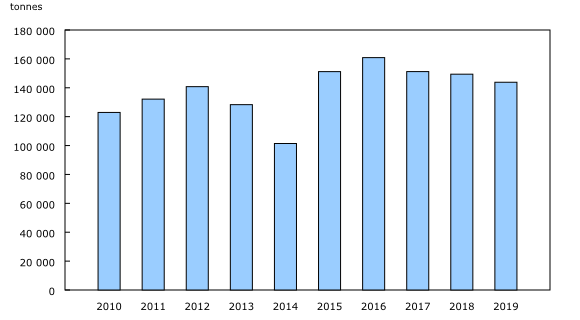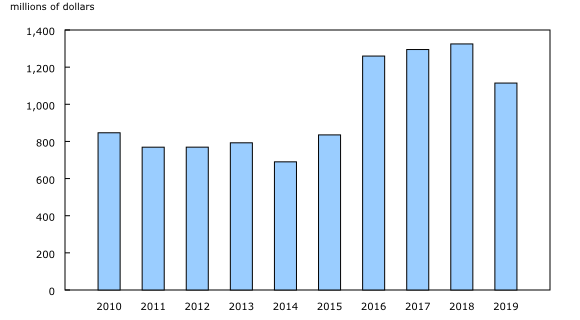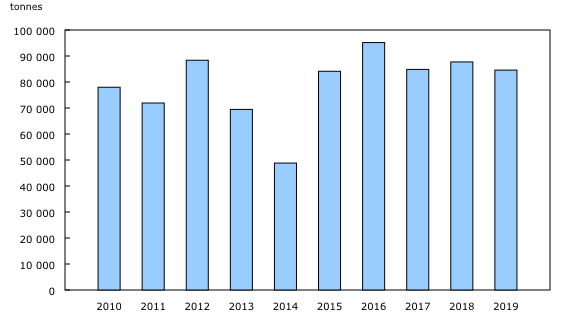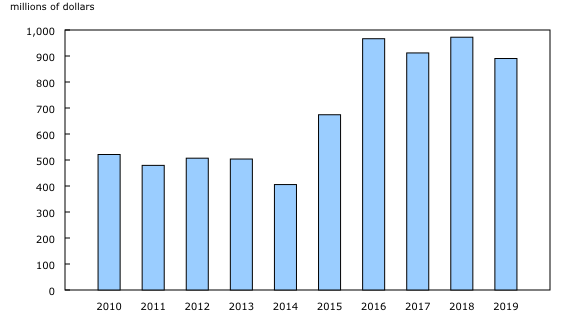Aquaculture, 2019
Archived Content
Information identified as archived is provided for reference, research or recordkeeping purposes. It is not subject to the Government of Canada Web Standards and has not been altered or updated since it was archived. Please "contact us" to request a format other than those available.
Released: 2020-12-24
Sales of aquaculture products and services were down 12.9% from a year earlier to $1.3 billion in 2019. The decline was mainly due to lower salmon production in Atlantic Canada and lower national prices for finfish products.
Salmon production in British Columbia rose 2.1% to 88 874 tonnes, accounting for close to two-thirds (61.8%) of the total Canadian finfish production in 2019.
Atlantic salmon is by far the most important aquaculture product in Canada. Aquaculture producers harvested 3.8% less finfish from a year earlier to 143 820 tonnes in 2019. The decline was mostly attributable to production in Atlantic Canada, where there was mass mortality, corporate restructuring and variabilities in total tonnage produced from one calendar year to another due to the three-year production cycle used in aquaculture management.
The value of total finfish products decreased for the first time in five years, down 15.9% from a year earlier to $1.1 billion in 2019. The decline was largely a result of the national farm gate price for finfish, which fell from $8.87 per kg in 2018 to $7.75 per kg in 2019, in addition to the lower production levels.
Export prices for farmed Atlantic salmon, including fillets, were down 5.0% from a year earlier to $10.53 per kg, while export volumes were also down (-3.6%), leading to an 8.4% drop in sales to $890.4 million. The United States is the largest importer of Canadian farmed Atlantic salmon with 83.8% of the total exports.
Sales of farmed mussel, which accounted for 3.4% of the total sales of aquaculture products and services in 2019, rose 4.3% to $43.7 million. The value of farmed mussel exports increased 3.5% to $48.7 million. Most of the mussel production in Canada is located in Prince Edward Island (77.8%).
The gross value added to the economy by the aquaculture industry—that is, the difference between gross output and total product inputs—decreased 37.3% from 2018 to $304.1 million in 2019, mainly due to a lower gross output, down 11.5% to $1.3 billion.
Note to readers
Aquaculture production and value data are provided annually by each of the provincial ministries responsible for aquaculture. Producers must report their production and value as part of their provincial licensing agreements.
Canadian export statistics are obtained from administrative records.
Revenue, expense and inventory data come from the 2019 Annual Survey of the Aquaculture Industry.
The publication Aquaculture Statistics was discontinued on November 17, 2016. All the data for this product can be found in tables 32-10-0107-01: Aquaculture, production and value; 32-10-0108-01: Aquaculture economic statistics, value added account; and 32-10-0005-01: Aquaculture, exports of selected Canadian aquaculture products, by destination.
Contact information
For more information, or to enquire about the concepts, methods or data quality of this release, contact us (toll-free 1-800-263-1136; 514-283-8300; STATCAN.infostats-infostats.STATCAN@canada.ca) or Media Relations (613-951-4636; STATCAN.mediahotline-ligneinfomedias.STATCAN@canada.ca).
- Date modified:





